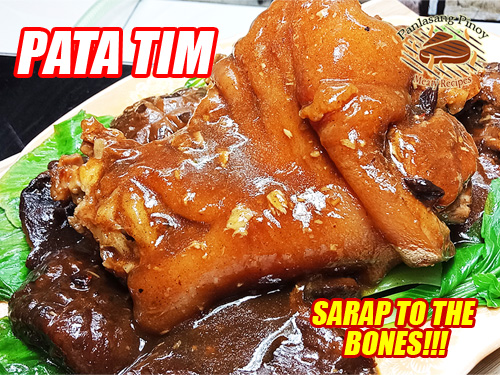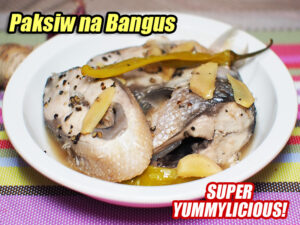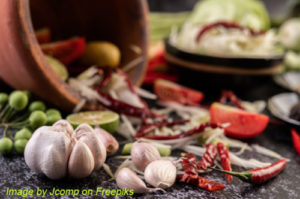Pata tim is a popular pork leg Filipino dish which is very similar to paksiw na pata but this dish does not have vinegar. This dish is basically cooked pork leg with a blend of soy sauce, oyster sauce, pineapple juice and spices like garlic, star anise and cinnamon and with vegetables like mushrooms and bok choy.
What makes this dish appetizing aside from it’s flavor is the very tender meat and the skin with gelatin like texture and thick savory sauce. Cooking this dish seems complicated and you might think that this can only be cooked by an experienced chef. But just reading the procedure, you will know that it is that complicated at all. If you have cooked some simple Asian dishes or Filipino dishes, then cooking pata tim is a breeze.
Why Pata Tim is a Filipino Favorite
Whenever I think of pata tim, I’m reminded of my lolo, who always made sure to bring a big pot of it whenever we had family gatherings in Pampanga. This dish, so tender and flavorful, captures the essence of Filipino home cooking with its melt-in-your-mouth pork hocks, rich, savory sauce, and the subtle sweetness from pineapple juice. It may look elaborate, but it’s surprisingly simple, even for beginners. Let me take you through this step-by-step journey of making the dish, just as my lolo once taught me.
What Makes Pata Tim Unique?
Pata tim stands out as a beloved Filipino dish, similar in some ways to the tangy paksiw na pata, yet distinct because it doesn’t use vinegar. Instead, it leans on a beautiful blend of soy sauce, oyster sauce, and pineapple juice. This combination, along with spices like star anise and cinnamon bark, gives the dish a unique sweetness balanced by earthy, aromatic undertones. The long cooking time results in a gelatinous, sticky sauce that clings to every piece of tender pork hock. It’s a dish meant to be savored with rice, its flavors deepening with every spoonful.
Preparing the Pork Hock the Right Way
One of the first things to remember when making pata tim is selecting a good pork leg. I learned from my uncle Carlo, a meat vendor himself, that you can save time by asking the butcher to chop the leg into 1½-inch-thick portions. This makes the cooking process easier and ensures that every bite is tender. Washing the pork leg well, soaking it for at least 30 minutes, helps to remove any remaining blood and reduces any strong porky odor. This trick, according to Tita Rosa, also helps tenderize the meat as it rests in the water.
For extra preparation, make sure the skin is clean by carefully burning any stray hairs using a kitchen torch or even the stove flame. My mom used to do this, and it’s a step that may seem minor but actually makes a big difference in presentation and flavor.
The Secret to That Mahogany Reddish-Brown Color
Once the pork leg is clean, searing it is essential. Heating up a wok with a cup of oil and lightly frying the skin gives the pata that golden-brown color that deepens beautifully as it braises. Not only does this technique add to the dish’s visual appeal, but it also locks in the flavors as the pork cooks. It’s a tip my cousin Jenny swears by, saying that it gives the final dish that restaurant-quality finish we all love.
Building the Rich, Flavorful Sauce
The sauce is the heart of pata tim, and creating it is all about layering flavors. Start with soy sauce and pineapple juice, which lay the foundation with salty-sweet notes. Add in garlic, star anise, and cinnamon bark, which infuse the dish with a hint of spice and warmth. My Lola Luisa, who always had her own twist on the recipe, liked to simmer the sauce with extra garlic for a more robust flavor. These spices work wonders in balancing the richness of the pork, resulting in a sauce that’s both hearty and slightly sweet.
After an hour or so of simmering, when the pork is starting to soften, add oyster sauce and a bit of sugar. This gives the sauce a luscious, glossy finish. Continue cooking for another 30 minutes until the pork is fork-tender and the skin has that soft, almost gelatinous texture that’s so iconic to pata tim.
Mushrooms and Bok Choy: The Perfect Finishing Touch
To complete the dish, add mushrooms to the pot. The mushrooms soak up the sauce, creating bursts of flavor with every bite. I always think of my cousin Mina whenever I add mushrooms, as she insisted they brought an “umami” richness to the dish. This ingredient enhances the overall taste, making the sauce even more savory and satisfying.
While the pata pim finishes cooking, prepare the bok choy by blanching it in boiling water for just a couple of minutes. This keeps it bright green and tender-crisp, adding a fresh contrast to the rich pork and sauce. When it’s time to serve, arrange the bok choy on a platter as a bed for the pork and mushrooms, then pour the sauce over everything. This presentation not only makes the dish more visually appealing but also keeps the bok choy from getting too soggy in the sauce.
Tips for Serving and Enjoying Pata Tim
Pata tim is a dish best served hot, right from the pot to the table. The thickened sauce, thanks to a bit of cornstarch slurry, should be silky and cling to the pork hock, enhancing every bite. And don’t be afraid to taste and adjust as you go. Some families prefer it slightly sweeter, while others might like a saltier touch. My Ate Liza, for instance, adds a splash of fish sauce at the end for a sharper, savory kick.
This dish is perfect for special occasions, but with how simple the recipe is, you can enjoy it on any regular weekend. The flavors are bold, complex, and comforting, making it ideal for a meal with family. Pata tim also makes excellent leftovers. The sauce thickens even more by the next day, creating a deeper, richer flavor that’s wonderful with a fresh batch of rice.
A Taste of Tradition
In every spoonful of pata tim, there’s a taste of tradition, family, and love. This dish is more than just a recipe; it’s a reminder of gatherings around the table, laughter, and stories shared with loved ones. The tenderness of the pork, the sweetness of the sauce, and the warmth of the spices blend together in a way that captures the spirit of Filipino home cooking. So whether it’s your first time making it or you’re perfecting your technique, know that each pot of pata tim is a tribute to generations who have passed down this delicious, comforting dish.
How To Cook Pata Tim
Ingredients
- 1 kilo pork pata pork leg or 1 whole pork pata
- 1 bunch bokchoy
- 3 Tbsp. soy sauce
- 1/4 cup oyster sauce
- 1 cup pineapple juice
- 1 whole star anise or sanke
- 6 cloves garlic crushed
- 1 stick cinnamon bark or 1/4 tsp. cinnamon powder
- 2 Tbsp. sugar
- 2 Tbsp. cornstarch
- salt or patis fish sauce
- 50 grams Shitake mushrooms optional or dried Chinese mushrooms
- 4 cups water
Instructions
How To Cook Pata Tim:
- When buying the pork leg, it is easier to prepare if you will ask the meat vendor to chop it for you about 1 1/2 inch thick. You can also use cook the whole pork pata.
- Wash the pork pata in running water and soak in water for at least half an hour to remove the all the blood and to lessen the odor.
- Wash and clean pata and drain. You can also soak in water for at least half an hour to remove the all the blood and to lessen the odor. Wipe with paper towel to dry. Remove hairs by burning it using a torch or lighter.
- You can also burn the hairs using your stove by passing it through the flames.
- This part, you have two options: retain the foot or trotters or cut it off.
- Ask the butcher to cut it for you or you can use a cleaver to chop it off.
- In a hot wok, heat at least a cup of cooking oil and sear the pork pata skin to remove odor and to have a nice reddish brown mahogany color when cooked.
- In a pot combine soy sauce, pineapple juice, garlic, star anise and cinnamon bark.
- Let boil and simmer for about an hour to 2 hours. Add more water if necessarily.
- Then add sugar and oyster sauce. Boil again for 30 minutes or until the pork is tender.
- Add in the mushroom and continue cooking until the skin is soft and with a gelatin texture and the liquid is reduced to half.
- Mix cornstarch with 3 Tbsp water and pour in to thicken the sauce. Season with salt or fish sauce to taste.
- In the meantime, wash and trim the bok choy. Blanch in a saucepan with boiling water for 2 minutes.
- Then mix the bok choy with the pork hocks and serve hot.
- You can make it more presentable by doing this: upon serving the pata tim, arrange a bed of blanched bok choy on a platter.
- Then put the pork leg pieces and mushrooms on the bok choy and pour over the sauce on the pork pata.
Video
Watch the Cooking Video Below:
Notes
Cooking Tips:
Choose the Right Cut of Pork
For a more tender and flavorful dish, select a fresh pork leg with a good balance of meat, fat, and skin. Ask your butcher to chop the leg into 1 1/2-inch thick pieces, as this size cooks more evenly and absorbs the sauce better. Ensuring the pork is properly cleaned and trimmed will also help reduce any strong, gamey flavors.Sear the Pork for Better Flavor
Searing the pork leg before braising is key to enhancing the dish’s flavor and appearance. This step locks in the juices, adds depth to the taste, and gives the meat a beautiful reddish-brown color. Make sure the oil is hot enough before searing to achieve a nice crust without overcooking the meat.Simmer Slowly for Tender Meat
Patience is crucial when braising the pork leg to achieve its signature tenderness. Cook the pork on low heat for at least an hour or until the meat easily pulls away from the bone. If necessary, add water gradually to keep the meat submerged in the sauce, ensuring it remains moist and flavorful throughout the cooking process.





This is so good
I just cooked it today and I love it, just the way my Mom cooked it in the Philippines. Thank you for this recipe
Hi Edna! Thanks for cooking this recipe! I hope you will also watch the video.
I tried the recipe for Easter lunch yesterday and it was so good! Since my family loves to put sauce on the rice, I doubled the measurements for it. Thanks for recipe!
Hi Blessie! Thanks for sharing your cooking experience! ðŸ˜
Can i use this measurements for four pata legs or need some adjustments.
Hi Jeoffry, Yes you need to adjust the amount of the other ingredients when cooking 4 pata legs. You can multiply it by four.
Pata tim is a yummy dish! some people include banana blossom in their recipe, may I ask when is the right time to add the banana blossom in cooking Pata tim? thank you!
Hi Tintin, I didn’t know that some people prefer adding banana blossoms on pata tim. But in paksiw na pata, banan blossoms are usually added a few minutes before it is cooked.
Hi Ann, I think you can use orange juice.
Instead of pineapple juice, what’s the alternative?
Will try your recipe on my birthday. Thanks.
Hi Geepet, advance happy birthday!
Hi Fely, good luck on your cooking!
I’ll try to cook this pata tim recipe tomorrow. Thanks!
Thanks for your comment too Willy. Yes you can omit the bokchoy but be sure to include the mushrooms.
Hi! Thanks for sharing this delicious pata tim recipe. Just want to ask if I can omit the book choy.
Recipes from Panlasang Pinoy is very helpful. Thank you and more power…